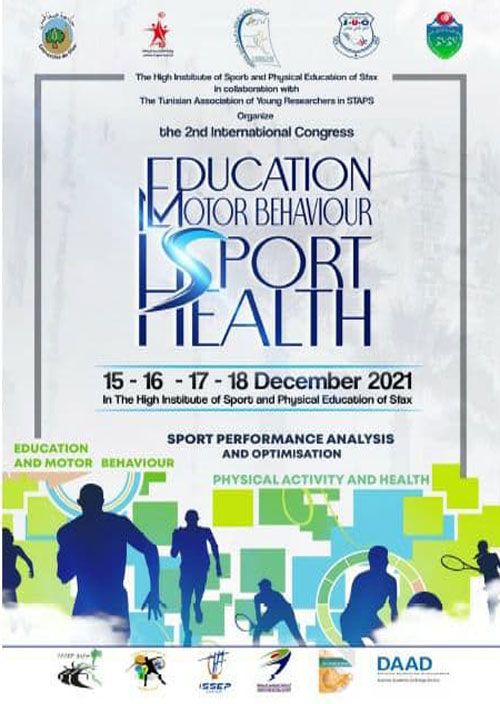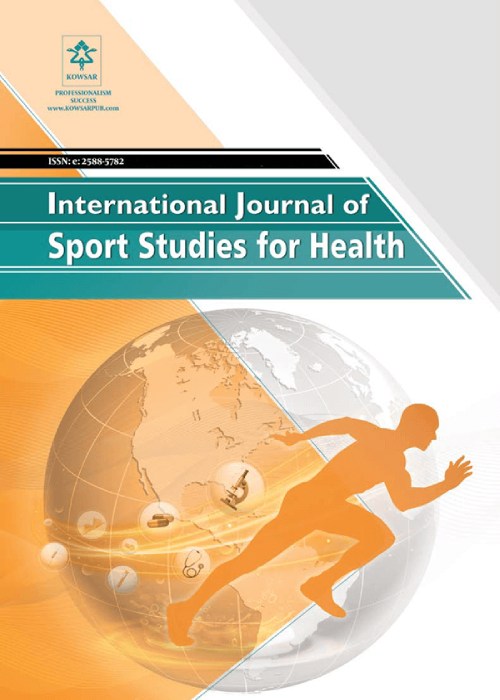فهرست مطالب

International Journal of Sport Sciences for Health
Volume:5 Issue: 1, Apr 2022
- تاریخ انتشار: 1401/06/27
- تعداد عناوین: 7
-
Page 1Background
Intrinsic and extrinsicmotivational factors can affect the levels of adherence of physical activity (PA) during the aging process.
ObjectivesInvestigate the intrinsic and extrinsic aspects and motivation that led older women to enroll in and adhere to a community PA program before the COVID-19 pandemic.
MethodsData were collected via transversal survey before the COVID-19 pandemic. The sample consisted of 21 women, participants of a PA workshop, aged between 60 to 86 years [< 1-year (n = 8) and ≥ 1-year (n = 13) groups]. Motivation was assessed by the Motivation Inventory for Regular Physical Activity Practice (IMPRAF-54), using the 60th percentile to categorize high and low motivation, and two open questions. For qualitative assessment, content analysis was used and the answers were framed into subcategories regarding the motivation factors for adherence and permanence.
ResultsThat adherence to the program was motivated by sociability purposes [total score: 36.0 (6.0), median (interquartile range)] and pleasure [34.0; (6.0)], while the main motivation for permanence was health [40.0 (11.0)]. Differences were noticed between the groups for sociability [38.0 (3.0) P = 0.030] and competitiveness [9.50 (12.0); P = 0.037] highest medians for the < 1 year group. Furthermore, the factors that least motivated older women were competitiveness and aesthetics.
ConclusionsHealth and sociability were the main motivators for the practice of physical activity among older adult women. Motivation played a fundamental role in the permanence of older adult women in the physical activity program.
Keywords: Motivation, Older Adults, Aging, Physical Activity, Women -
Page 2Background
Emotional intelligence (EI) and emotional competence (EC) are considered as multidimensional strategies for dealing with various complex situations. There are conflicting results regarding the effect of age, gender and sports status on EI and EC dimensions.
ObjectivesIn the present study, we compared the EI between young athletes and non-athletes, as well as in terms of both genders and different age groups
MethodsFour hundred seventy-nine young individuals (239 athletes, 240 non-athletes) aged 12 - 18 years old participated in this study. They were classified according to their age (12 - 15 years and 16 - 18 years) and gender (239 male, 240 female). All participants completed the Profile of Emotional Competence (PEC); for assessing the intra- and interpersonal EC and global EI.
ResultsAthletes had significantly higher values of global EI and altogether the intra- and interpersonal EC dimensions (all, P < 0.001). The comparison between genre and age groups highlighted those males and younger participants showed significantly higher components for both inter- and intrapersonal EC and global EI than females and older participants respectively (0.05 < P < 0.001).
ConclusionsBased on the result of the current study, we conclude that engagement and involvement in sports can be considered as a key factor for developing adequate EI. Psychologists and sport-scientists need to be aware about the specific-related psychological skills for both age and gender requirements, particularly EI.
Keywords: Emotion, Intelligence, Gender, Age, Sport Status -
Page 3Background
Recent research indicates the prevalence of vitamin D deficiency worldwide and is conflicting evidence as to whether vitamin D supplementation actually improves physical performance.
ObjectivesThe purpose of this study was to investigate the effect of vitamin D supplementation on improving muscle strength, muscle volume and cardiorespiratory fitness through resistance training in male athletes with vitamin D deficiency.
MethodsThis study was conducted with pre-test and post-test series design and quasi-experimental method. The population included 36 male futsal players with vitamin D deficiency that were randomly divided into four groups of nine: exercise (EX), exercisesupplement (EXS), supplement (SUP) and control (CON). SUP and EXS groups received vitamin D3 (50,000 intramuscular injections) every two weeks for 8 weeks and performed three resistance training (RT) sessions per week at a rate of 75% 1RM. Before and after intervention, blood sampling were drawn and measurements performed for 1RM, muscle volume (cm2 ), and VO2max by standard Bruce test. Correlated t-test was used to compare pre-test and post-test results and to measure the differences between groups, one-way analysis of variance and LSD post hoc test were used using SPSS statistical software.
ResultsMuscle volume increased significantly (P-value = 0.001) only in EX and EXS groups. Cardio-respiratory fitness did not change significantly in any of the groups (P > 0.05). There were no significant differences between EXS and SUP groups for any of the measured variables (P ≥ 0.05).
ConclusionsIt seems that simultaneous application of vitamin D supplementation and resistance training for 8 weeks does not have a significant effect on the improvement of the strength and endurance of futsal players.
Keywords: Cardiorespiratory Fitness, Muscle Strength, Resistance Training, Vitamin D -
Page 4Background
Researchers believe the beneficiary role of some supplements in improving futsal player’s performance, since their performance is disturbed by lactate accumulation.
ObjectivesTherefore, in the present study, the acute effect of high-carbohydrate and high-caffeinated drinks on motor performance (speed and coordination) and cognitive function in futsal players was investigated.
MethodsA quasi-experiment method with pretest-posttest with control group was used. 40 participants were randomly divided into 4 groups: (1) carbohydrate supplementation (N = 10); (2) caffeine supplementation (N = 10); (3) carbohydrate and caffeine supplementation (N = 10); (4) control group (placebo). Two carbohydrate and caffeine sports drinks, one dose each at the rate of 6 mL per kilogram of body weight) and placebo were prescribed to the subjects. Speed was measured by 36-m sprint test and coordination was measured by dribble and shoot test. A modified version of the continuous performance test (CPT) developed by the researcher for use in futsal players was also used to measure cognitive performance.
ResultsCarbohydrate had a significant effect on reaction time (as cognitive performance) and coordination (P ≤ 0.05). Additionally, caffeine was associated with a significant improvement in cognitive performance (P≤0.05), but no significant effect was found on speed and coordination (P≥ 0.05). Moreover, those who had carbohydrate supplement with caffeine had improvement in speed, coordination and cognitive performance (P ≤ 0.05).
ConclusionsTaking a supplement in the form of a combination of carbohydrate and caffeine 5 days before the performance will have a positive result in speed and coordination tests.
Keywords: Cognitive Performance, Futsal Players, Caffeine, High Carbohydrate Drinks -
Page 5Context
A model of agility ladder tool was designed in the current study to increase cognitive-motor performance in athletes with more advantages over conventional agility ladders.
ObjectivesThe aim of this study was to develop agility tool for athletes using Jami agility table (JAT) which has been the latest training model by creating mental challenge and recruiting muscle movement units for agile performance of sports skills.
MethodsIn this descriptive-analytical study, a systematic review of agility development methods were presented to improve psychomotor performance in athletes and then the JAT agility table model was introduced. Based on the JAT, a special code is designed in order to develop agility both physically and mentally aspects, and athlete is always engaged with new algorithms of movement.
ResultsOne of the exclusive functions of JAT, is to increase contextual interference in the performance of motor skills which increases reaction time (RT) in athletes significantly. Laterality detection and empowering non-dominant hemisphere is one of the applications of the JAT, which ultimately increases the comprehensive development of the central nervous system (CNS).
ConclusionsThe most important aspect of JAT is based on increasing contextual interference and random learning in learners and athletes. Additionally, neuromuscular coordination is one of JAT functions which would improve agility performance in athletes. JAT mechanism has been designed based on Movement algorithm models. In such a training model, which imposes a better cognitive function on the learner and athlete to create better motor memory, the process of constant algorithms is converted into variable and instantaneous algorithms, resulting in more reliable motor outputs.
Keywords: Jat Agility Table, Contextual Interference, Movement Algorithm, Neuromuscular Coordination -
Page 7Background
The purpose of the present study was to assess the impacts of plantar-flexors and dorsi-flexors fatigue following isokinetic contractions on postural control in nine young healthy national level judo athletes.
MethodsParticipants were required to stand still on a force plate with opened and closed eyes in feet together (FT) and single leg (SL) stance before (PRE) and after (POST) an isokinetic fatigue protocol. Mediolateral sway (ML sway), anteroposterior sway (AP sway), and velocity sway were calculated and used to assess the postural control.
ResultsVelocity sway POST was significantly (P < 0.001) higher than PRE in FT stance and SL stance. Velocity sway POST was significantly higher in the SL stance than the FT stance (P = 0.01). During eyes closed, a significant interaction postural task by fatigue for all parameters was found. All parameters increased significantly after fatigue compared to PRE. After fatigue, ML sway, AP sway, and velocity sway were significantly higher for the SL stance than the FT stance.
ConclusionsAnkle muscle fatigue led to reduced postural stability during different stances in young healthy judo athletes. This effect was more accentuated when vision was removed and the base of support was reduced. Alteration of postural control depended on the difficulty of the postural stance.
Keywords: Posture, Judo, Balance, Muscle Fatigue, Lower Limb


